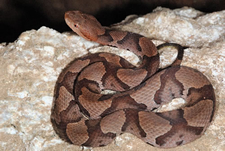Venomous Snakes
The Copperhead: Under rhododendrons along the Blue-ridge escarpment, in piedmont woodlots, and along fence rows in rural gardens, the copperhead abides. Certainly it does well in expansive wilderness, but it only needs 1 or 2 acres of habitat, a healthy population of white-footed mice, and a place to lay-up in the shade, and it will survive. This animal, with its highly camouflaged coloration and venomous bite, has been a concern to people over the centuries. It will likely remain so into the future.
Copperheads are light to rich brown colored snakes with darker brown hourglass shaped markings across their backs, the narrow waist of the glass being at the center of their back. This color and pattern reminds an observer of fallen leaves. The connection is appropriate, for while it will readily wander into fields in search of food, this is a creature of the forest. Its coloration serves its main protective strategy which is to remain motionless and hopefully not be seen. However, if stepped on or otherwise seriously provoked or frightened it will defend itself as most animals will do. Typically adults are about 24 to 30 inches in length, but individuals over 3 feet are not rare.
Note: newborn copperheads resemble adults in coloration, except that the last half inch of the tail of the young snakes is a distinctive sulfur yellow color. This largely fades to brown by their second year.
 |
Copperhead (Agkistrodon contortrix): brown hourglass markings on back, 3 |
 |
Timber Rattlesnake (Crotalus horridus): Yellow, gray, to black snake with cross bands, rattle on tail, 2 |
The Timber Rattlesnake: A list of some memorable wildlife observations that can be made in upstate South Carolina might include the autumn hawk migration at Caesars Head State Park, loons singing on Lake Jocassee prior to their spring migration north, or a black bear moving through a mountain forest. There are many others. One of these others is seeing, for the first time, an adult timber rattlesnake in its natural habitat.
Most people have never seen a rattlesnake in the wild. And while the opportunities are declining in the upstate (these snakes have been eliminated from much of the piedmont through the activities of people), they can still be found in the mountainous areas of the state. Most of these areas are now in public conservation ownership and as a result the timber rattlesnake, an icon of the eastern deciduous forest, has a better opportunity for long term survival.
In the upstate timber rattlesnake adults may average 3 to 4 feet in length. However, they can reach 5 feet long. This species is highly variable in the upstate. Some specimens display pattern and coloration typical of the “timber” (montane) phase, being either yellow/gray with brown cross-bands or almost entirely black. Other specimens in the upstate appear to be the “canebrake” (coastal plain) form of the timber rattlesnake, with a tan-gray base color, black cross-bands and a red stripe running the length of the body down the spine. These are all the same “species” of rattlesnake and all of these “variants” can co-occur.
The young are born with a single rattle (button). A segment is added to the rattle each time the snake sheds its skin. As the string of rattle segments elongates it is periodically broken off by happenstance. Thus individual adults of similar size can have rattles of various lengths.
If you do chance upon an adult rattlesnake it will impress and maybe even startle you by its girth and overall size, its large head, its rattle, and by the fact that you know that it is dangerous if improperly approached. Stay safely away, look, take only photos for your trophy, and appreciate your safe encounter with this unique animal.
Timber rattlesnakes feed on mammals including mice, chipmunks, and gray squirrels. They are not aggressive toward people, and a major protective strategy is to remain motionless and unobserved. However, individuals vary in temperament regarding the use of their rattle. Some will allow you to pass within a few feet of them without responding, while others will rattle at any approach.
